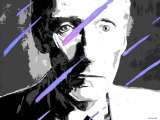 |
Old Bull Lee A Voice From the Reality-based Community Notes from a Study of Things Themselves |
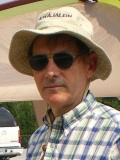 |
Mulholland Drive as a Stream of Consciousness Film
This is how the movie opens.
A black limousine moves slowly along Mulholland Drive at night, following the dark, winding road that runs high above Hollywood and west LA.
The passenger is a beautiful woman, elegantly dressed.
The limo stops and the woman protests: "We don't stop here."
The driver turns around in his seat and points a pistol at the woman's face.
Before she can react, another car, full of drunken, screaming youths, slams into the limousine at high speed.
As the dust settles from the horrific collision, the woman emerges from the limo. She's unsteady but uninjured. She surveys the wreckage, observes that she's the only survivor, and walks down the hill, into the woods, and towards the lights of Los Angeles, spread out below.
For the next two hours the woman from the wreck, alternately called "Rita" and "Camilla," interacts with another woman, alternately called "Betty" and "Diane." They're both actresses who interact with Adam, a director. The film shows us a long series of strange, sometimes disconnected scenes that appear to be hallucinations or dreams.
Mulholland Drive is baffling on first viewing. That's because the narrative structure doesn't become evident until almost the very end. And even then it isn't obvious. And by that time the viewer realizes he hasn't paid close enough attention to the scenes, characters, and events seen earlier.
Some give up in frustration and vow never to watch another David Lynch film. Others are intrigued and watch the film again to review particular segments.[1] Some watch it repeatedly, searching for ever deeper understanding with each viewing. The latter group has turned the Mulholland Drive into a cult favorite.
An analysis is offered below for those who've seen the film at least once, yet still feel clueless. For those who've never seen the film or who want to sort it out on their own, I offer three hints:
Hint #1: Review in your mind the story line of the 1939 classic The Wizard of Oz.
Hint #2: Pay close attention to the strange scenes in the first three quarters of the film and keep faith they'll start to make sense at the end.
Hint #3: Be aware that Mulholland Drive is a two-lane road that runs along the crest of the Santa Monica mountains, two thousand feet above the Los Angeles basin and behind the famous Hollywood sign. Homes along this road have spectacular views of the city and Pacific Ocean. Residence there is an emblem of success in the film and entertainment industry. Marlon Brando, Jack Nicholson and Mary Tyler Moore have owned such places. David Lynch, the director, lives near Mulholland Drive.
Mulholland Drive employs the literary technique known as stream of consciousness. That is to say, the narrative records the thoughts and impressions of one or more fictional characters. Well known stream of consciousness works include the novels Ulysses by James Joyce, To the Lighthouse by Virginia Woolf and The Sound and the Fury by William Faulkner.
The film Mulholland Drive records the consciousness of Diane Selwyn, a minor Hollywood actress. Her consciousness transitions among four states.
- Her real life, or consciousness while awake. Diane's real life in the film takes place entirely in her apartment.
- Her memories from her own life. In film lingo these are called "flashbacks." Diane's flashbacks at the end of the movie are critical to understanding the film.
- Her dreams, or consciousness while sleeping. Dreams are constructed in the mind from real life memories and populated with remembered and imagined characters. In Diane's dream Camilla appears as Rita, Diane appears as Betty and the Winkie's waitress is named Diane. In Mulholland Drive the dream characters are introduced before they are seen in Diane's real life or memories. In The Wizard of Oz, a similar but more accessible film, the viewer sees dream characters--the Cowardly Lion, the Tin Man, the Scarecrow and the Wicked Witch of the West--after they are seen as real characters, namely the three farmhands and Miss Gulch.
- Her hallucinations, which are constructed with real and imagined characters, including characters remembered from her dream.
The Narrative: A Long Dream Followed by Six Flashbacks
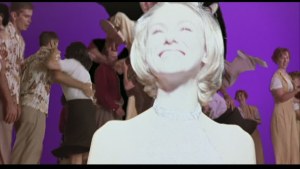 | 0:02:00 Images from the dance contest flow through Diane's mind. |
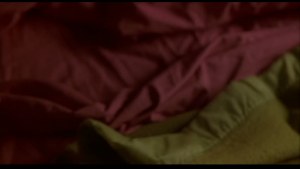 | 0:02:30 Diane falls asleep in her bed. Her dream begins and goes on for nearly two hours. |
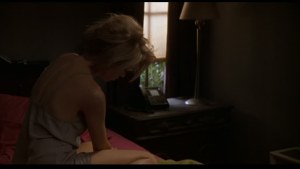 | 1:57:30 Diane wakes up. Someone's knocking on the door. It's her neighbor, seen earlier in the dream. The neighbor comes in, collects a few items and leaves. Diane puts on coffee. |
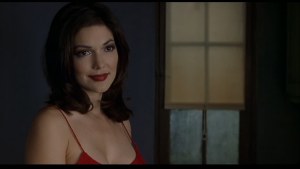 | 2:00:45 - Flashback #1 Diane turns around and sees Camilla in the apartment. Startled, she realizes it's only a memory (or hallucination): Camilla isn't really there. So Diane returns to the coffee pot. |
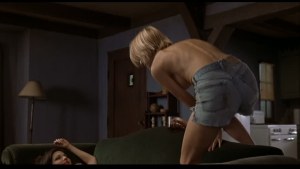 | 2:02:03 - Flashback #2 Diane's vision of Camilla triggers a series of memories. First, there's the intimate encounter with Camilla on the sofa. (Note that Diane is wearing cutoff jeans, not the robe.) Camilla rebuffs Diane; says their relationship must end. |
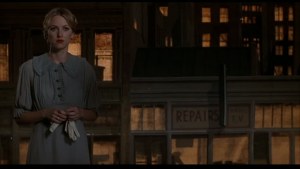 | 2:03:36 - Flashback #3 Diane remembers the filming of a scene from The Sylvia North Story. Diane watches Adam demonstrating to an actor how to kiss Camilla, who's sitting in a car. It's clear that something's going on between Camilla and Adam. A tear runs down Diane's face. |
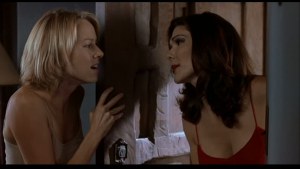 | 2:05:54 - Flashback #4 Diane remembers angry words with Camilla at the door of the apartment, then crying and masturbating. Note Diane is still wearing the cutoff jeans. |
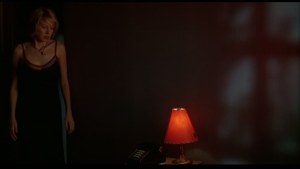 | 2:07:30- Flashback #5 Diane remembers taking Camilla's phone call about the waiting limo. The ride up Mulholland Drive resembles the one at the beginning of the film, even including the line, "We don't stop here." Some of Adam's party guests were seen earlier in Diane's dream. Coco the apartment manager has become Adam's mother. The cowboy is seen walking across the room. One of the Castigliane brothers is sitting at another table. The "blonde Camilla" from the Sylvia North Story audition singing "Every Little Star" shows an unexpected familiarity with Camilla. She kisses Camilla on the lips and walks away with a lipstick smear, glancing back at Diane in a way that telegraphs the message, "I was Camilla's lover, too." At the party Adam jokes about his ex-wife, "I got the pool and she got the pool man." This remark might be the only thing Diane knows about Adam's relationship with his ex-wife. If so, Diane's hilarious dream sequence involving Adam coming home and finding his wife in bed with the pool man would have been constructed wholly from her imagination. |
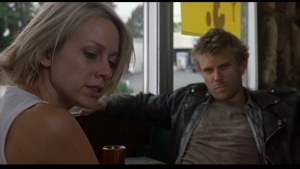 | 2:16:48 - Flashback #6 Diane remembers paying Joe to murder Camilla. At Winkie's they are served by a waitress named "Betty." When Diane looks up from her table, she sees another character from her dream, the man who was troubled by his own dream. This memory triggers a hallucination of the scary person hiding behind Winkie's. |
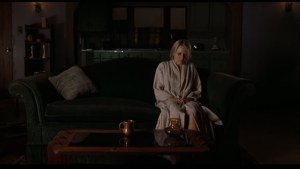 | 2:20:02 Diane despairs. She's suffered professional failure and romantic rejection; then, at Adam's party, humiliation. She's paid her inheritance to have Camilla murdered and cops are looking for her. She hallucinates that the old couple who wished her success and happiness early in her dream have sneaked under her apartment door. |
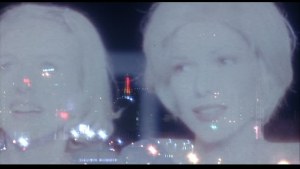 | 2:23:04 In Diane's final thoughts before dying, she sees herself as Betty, the ingenue from her dream. |
Going Beyond the Narrative
Mulholland Drive's narrative structure is a riddle that has a solution. But the nature of Diane's psyche is an open-ended riddle that may not have a solution. What, if anything, can a film viewer learn from seeing two hours of a person's dream? What did the director want us to think?
Clearly, Diane is a troubled woman. But her dream suggests she sees herself as innocent and hopeful for a successful acting career. In reality, her film career has been a failure and she rationalizes that failure in the dream with a belief that film roles are selected by gangsters, not directors who recognize talent. The dream hints that she's not so innocent, either. There's the scene where a girl that looks similar to Diane is playing up to Joe, the pimp and murderer. And the Winkie's waitresses look a lot like Diane, too, and there's the Winkie's mug in Diane's apartment. Is the director telling us that Diane once worked the streets of Hollywood as a prostitute? And maybe at other times served diners in the unglamorous role of a waitress?
Betty's audition scene is particularly intriguing. She plays a young woman in the arms of an older man--a friend of her father--with whom she's having an affair, perhaps an abusive one. She says she wants to break off the relationship, but her expression and body language belie her words. Betty performs her role flawlessly. Everyone in the room applauds her except the director, who is inattentive and prone to make remarks that make absolutely no sense. Does this scene suggest Diane was involved in such an affair? Maybe something of this sort caused her to flee Deep River, Ontario. At the same time, is David Lynch, a major film director himself, making a statement about the nature of auditions, casting and directing in Hollywood?
Mulholland Drive presents us with an endless stream of questions that may or may not have answers. For example, where did the cigarette butts in the ashtray under the red lampshade come from? Hours can be spent pondering such mysteries. For interesting theories and speculation, check out the website Lost on Mulholland Drive.
[1] Unfortunately, the DVD version of Mulholland Drive isn't broken into chapters. As a consequence the viewer can't do "scene selection". If any movie ever needed scene selection, this is it.